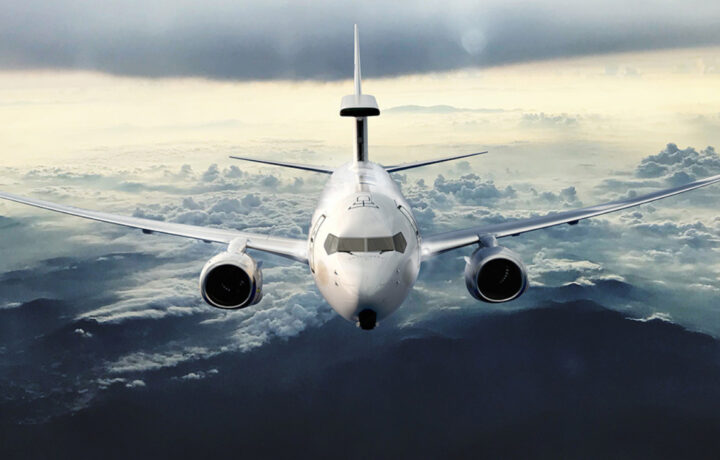In February 2023, Boeing announced it had received a United States Air Force contract to produce the E-7 Airborne Early Warning & Control Aircraft (AEW&C). The aircraft had been selected by the air service in 2022 to replace its aging fleet of E-3 Sentry Airborne Warning and Control Systems (AWACS), and the Air Force had sought to acquire 26 of the planes from the aerospace firm in a deal valued at $1.2 billion.
The E-7 – a heavily modified next-generation 737-700 – was selected in part due to its well-established supply chain, which was seen to significantly reduce maintenance and logistics costs while increasing mission readiness. In addition, the E-7 offered the ability to capitalize on existing commercial derivative aircraft design, certification, and modification processes, allowing the AEW&C planes to be fielded to meet Air Force needs.
Program Turbulence
Since the deal was formally announced last year, there has been some turbulence that has led to delays, notably the aircraft’s engineering costs, which Air Force Secretary Frank Kendall told the Senate Armed Forces Committee in April was higher than expected.
“The price that we got from the prime came in much higher than we had anticipated,” Kendall told lawmakers on Capitol Hill.
Kendall added that while the Air Force “was still committed to the program,” the service also needed to acquire “an affordable aircraft.”
Air Force Called in a Closer
Negotiations related to the cost of the E-7 Wedgetail dragged on for more than a year, but it was announced last week that the U.S. Air Force has reached a deal with Boeing to move forward with the purchase of two E-7s.
“We have reached an agreement with them. We haven’t quite definitized a contract with them, but we expect to do that in August. What we did was we brought back a former colleague of mine … to negotiate with Boeing and to drive to closure on the program: Mr. Shay Assad,” Kendall told reporters at the Royal International Air Tattoo in the UK on Saturday.
As Defense One reported, Assad served as the Department of Defense (DoD’s) top weapon-buying negotiator in the 2010s and was previously credited with saving taxpayers “hundreds of millions of dollars” in deals with Boeing and Lockheed Martin. Assad was brought in after the Air Force was unable to close the E-7 deal with Boeing.
Deal Reached
The two sides were eventually able to reach an agreement, which included the Air Force’s investment in upgrading mission systems aboard the Wedgetail. That could make the E-7 attractive to potential international customers.
“There is credit here for Boeing and the suppliers. They did really buckle down and get their pencils out and sharpen them and do a good job to bring the cost of the rapid prototyping program down. That’s what we asked. And that’s what they did,” said Andrew Hunter, the Air Force’s top acquisition official.
“Why did they do that? They did that because there is an extensive market for E-7 going forward not only with the Air Force, but also with NATO and other partners,” added Hunter. “And so the business case was there for them to lean forward and get over the hump, if you will.”
Eyes in the Sky
The early warning aircraft was developed as part of Project Wedgetail for the Royal Australian Air Force (RAAF) in the late 1990s. The RAAF operates six of the aircraft, while four are service with the Republic of Korea Air Force as the E-7 Peace Eye, and four more with the Turkish Air Force as the E-7T Peace Eagle.
The UK’s Royal Air Force has three of the radar planes on order, while it could expand the order by an additional two. NATO has also ordered six of the E-7s to serve with its Airborne Early Warning and Control Force.
The E-7 is equipped with modernized communication systems that are interoperable with other military forces, including ground, naval, and air units; while the systems were designed to enable secure, interference-resistant data links that can ensure critical information can be transmitted even in contested environments. In addition, unlike previous radar systems – including those on the E-3 – it can be employed to redirect power from other sensors, which reduces the range and identification capabilities.
The aircraft has a maximum altitude of slightly less than 12,500 meters, and an unrefueled range of 3,500 nautical miles, with an “Identification Friend or Foe” range of 300 miles.
The Air Force has called for a slightly modified design to its E-7, which will meet U.S. satellite communication, military GPS, cybersecurity, and program protection requirements.
Boeing’s Plea Deal Won’t Affect This Deal
A formal contract for the first two E-7s is expected to be finalized in August, and it would be the first major contract awarded to Boeing since the aerospace firm agreed earlier this month to plead guilty to criminal fraud conspiracy charges related to the U.S. Department of Justice (DoJ) investigation into a pair of Boeing 737 MAX crashes more than five years ago.
As Boeing agreed to plead guilty to a felony, the aerospace firm would normally be excluded from bidding on military contracts. However, the Pentagon has the leeway to grant exceptions.
“We will be working in a coordinated fashion … to understand what implications there might be from the plea deal, but I don’t anticipate at this point that it is going to … lead to significant disruption of our contracting,” added Hunter.




